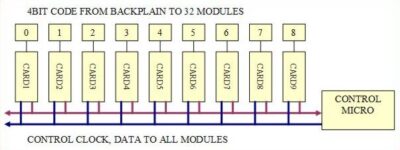RMOS system, OB trucks and PAM
The RMOS ( Ringmain and outside source ) system originated in 1997, where there was a requirement for Analogue Stereo Program switchers of sizes to 64×32 coupled with a reverse Cue switcher of about 16×8 for Radio Stations. A compact Balanced analogue switcher Eurocard of size 16×8 was designed, and many could be controlled with two common wires from a processor card. This became known as B2C ( Board to computer! )

The processor was the massive(!) Dallas 80C320 ( 64K ROM, 32k RAM ) which could deal with TWO serial ports and run at about 5MIPS. ( This was last century!)
One serial port was devoted to RS232 setup and management, and the other ran RS485 to up to 63 control panels. RS485 is notorious to get working reliably, but this was solved by coding each control panel 0-63, and make the main processor poll all modules in turn. Thus control panels were only allowed to speak when they are polled, and data clashes avoided. No systems had that many control panels, so the knowingly connected panels were polled often, and unknown panels polled occasionally so that good response was obtained from connected panels and the system learnt what panels were there.

Good response was also obtained by using the fastest baud rate available for the chips ( 176kbaud) and using panel-specific + panel-all response data, keyed against a destination number. The panel-all response meant that theoretically up to 63 panels were updated in under 10ms, giving a fast, attentive system.
The first control panel ( BCD970210) used an LCD button with shaft encoder. Later control panels used a key+led architecture, and the biggest had 64 buttons, and level pots.
Other companies produced more standard products so sales were never high. However a number of interesting custom projects arose, including the World service central monitoring system twice! ( 2001 and later 2005 )

Over time, more modules and control panels were added, so that selectors, relays and digitally controlled mixer cards were possible.
A number of IFB ( Interrupted foldback ) systems were produced for clients. The mixing abilities of the Sigmix card was perfect for the monitoring LS and Headphones, with front panel level pots, signal detect etc. PTT switches for outgoing talkback can automatically cut or dim the incoming channel. These ideas were used in OB trucks.
A talkback and mixer system was designed for BBC OB trucks in 2008, and is still in use today.
That used the BCD080619 ‘Sigmix6’ card as the remote mixer element, and the 16×8 card for routing. The control panels now included pots and switches, but still communicated by the RMOS RS485 protocol. The processor on one the Sigmix6 cards was capable enough to serve as the rack processor in its own right. ( The C8051F410 used runs at 49MIPS)
The PAM system also originated from this time, and has the same underlying RS485 protocol.
A dedicated processor card with multiple RS485s was used, as one deployment required 8 Galleries to be cross-assigned to 8 Studios. (BCD100719) The card was also given Ethernet, and could support basic ARP, ICMP and UDP protocols, but modern HTTP web browsing was beyond its capabilities. The Sigmix6 card did everything one Presenter needed, and up to 8 cards were possible in the Installer-48 rack. GPI and relay cards completed the system.
Many systems were produced, the latest from 2019, and a 2010 installation was upgraded with more outstations in 2022.

